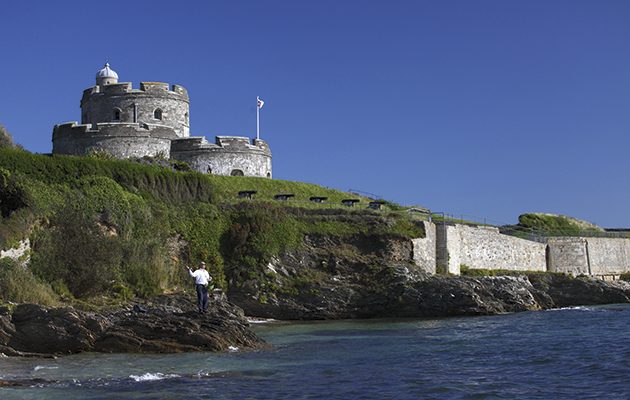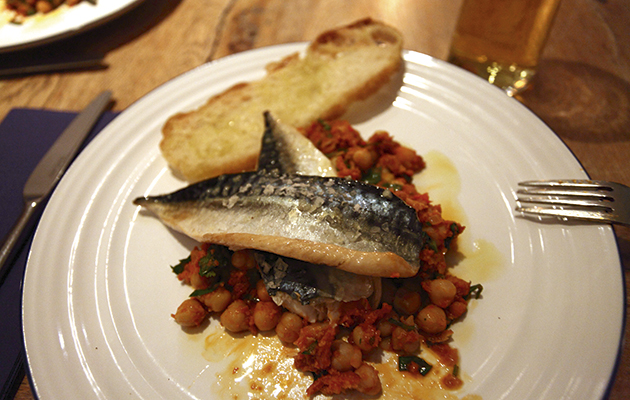With saltwater fly fishing gaining in popularity, our writer headed to Cornwall last September to try his luck at the inaugural Saltwater Fly Fishing Festival. Words and photographs Tobias Coe
The Field’s writer headed to Cornwall to try his luck at the inaugural Saltwater Fly Fishing Festival last September. With the Festival set for its second installment, Tobias Coe offers his advice on beating the competition.
There’s no need to travel abroad for a fly fishing experience that will really get the heart pumping. Read fly-fishing for shark in the UK.
THE SALTWATER FLY FISHING FESTIVAL
The venerated ancestors of fly fishing, such as Frank Sawyers and GEM Skues, perfected their art on clear, calm streams. Fast forward to the present day and the range of species pursued and habitats in which flies are cast has increased exponentially. Few anglers can have failed to notice the rise of saltwater fly-fishing over the past couple of decades and intrepid UK anglers now head off, fly-rod in hand, to chase mackerel, pollack, bass and a host of other species.
Saltwater fly fishing is practised around pretty much the whole of the UK, however, the species favoured differs depending on location. In the south-west, bass are king, with good reason. They readily take flies, fight well and are stunning to look at. This combination of quarry and fishing method is intrinsically appealing even to non-anglers. This is evidenced by the organisers of the newly established UK Saltwater Fly Fishing Festival, Amelia and Tim Whitaker. Based in St Mawes, south Cornwall, the pair aren’t fly anglers – indeed, other than occasionally dabbling for mackerel, they wouldn’t count themselves as anglers.
Having seen a few anglers fly-fishing from the rocks around St Mawes or out fishing on the specialist charter boat Zen2, run by Austen Goldsmith, the Whitakers came up with an idea. “We saw this fantastic experience that some people were taking part in, right here in the UK,” Amelia Whitaker explained. “In contrast, we heard stories of anglers paying thousands of pounds to go overseas to fish in the sea. So we thought it would be an idea to start a festival. It’s a weekend where people can come to Cornwall and experience saltwater fly fishing, meet fellow anglers and take part in a light-hearted competition.”
THE SALTWATER FLY FISHING FESTIVAL: THE WEEKEND
The festival is held over the course of a long weekend, the itinerary involving demonstrations, talks and gatherings on the first day. The competition takes place over the Saturday and Sunday. This is relatively simple: anglers are allowed to fish within a specified area (explained clearly with maps at registration on the Friday evening), with fly-fishing kit, from 6am, which, at the time of the festival in mid September, corresponds roughly to first light. All fish caught count and the overall winner is the angler who catches the greatest total length of fish over the weekend.
I hoped to take advantage of the relatively early start last year, when I went down to Cornwall to participate in the inaugural festival. Meeting up with the organisers on the Friday night, I ascertained some of the spots worth trying over a pint at registration in the rather lovely St Mawes Hotel. In particular, I hoped to get some information on potential rock marks. My rational behind this was that such locations are typically haunted by large numbers of small pollock. While they don’t usually run much bigger than a couple of pounds, they are often numerous and show a keen propensity to bite during the low light of dawn and dusk.
THE SALTWATER FLY FISHING FESTIVAL: AN EARLY START
I had to remind myself of the advantage of an early start at 4.30 as I hauled myself out of bed. Heading off along the narrow Cornish lanes, I made my way to the stretch of coastline that faces due east, near Porstcatho. Accessed via the South West Coast Path, this area is a mixture of rock ledge, small sand and gravel beaches and kelp beds. The perfect hunting ground for pollack, as well as bass.
Setting up at the car, I headed off into the gloaming along the coast path. I found what I was looking for quickly: a rocky ledge, festooned with barnacles and limpets, the ebb and flow of wind chop washing up the face of the rocks. As the sun crept over the horizon, I made my first cast.
THE SALTWATER FLY FISHING FESTIVAL: DARK-BRONZE POLLACK
Having chosen to fish a heavy sinking shooting head, this wasn’t an elegant affair, consisting of a quick roll of the head out onto the surface of the water, a hard haul into the back-cast and then a single forward stroke to shoot the whole lot towards the horizon. Beautiful pointed loops it is not but this kind of set-up cannot be beaten for delivering a fly quickly with minimal effort.
With a fast-sinking line on, a couple of seconds pause was all that was necessary before starting to strip the small sand eel imitation back towards me. On the second cast, I felt a knock on the line that I thought initially to be the fly catching seaweed, until the seaweed gave a couple of kicks and pulled back. A lovely, dark-bronze pollack appeared from the waves shortly afterwards and I was saved from the embarrassment of a competition blank.
Over the next hour or so, another two pollack came to hand and I lost a couple of others before the bites dried up as the sun slid higher into the sky. From a fishing perspective, the rest of the day was a bit of a write-off. A brilliant, bright-blue-sky day is always tough conditions for fishing from the shore and this proved to be true for almost all the anglers on day one. At the count that evening, no bass were reported caught and my early morning sortie put me in the lead with a total fish length of 97cm for my three pollack.
THE SALTWATER FLY FISHING FESTIVAL: DAY TWO
The next day I set out to try and repeat my success from the previous morning but it was not to be. My plan was to make my way to the rocky promontory across from St Mawes, however, once there I realised that the only way to get down to the spot I wanted to fish was by way of an abseil down a near-vertical cliff face. I aborted the plan and headed back around the coast to the ledges I had fished the day before but a stiff, easterly breeze and lumpy swell meant I ended fishless after my early morning sojourn.
Weather-wise, the day was a repeat of the one before, with bright sun throughout. With the pollack off the bite I spent much of the day fishing around the castle at St Mawes, a known hot-spot for bass. The tide pushes through this area and the rock ledge that extends up the Fal estuary from the castle drops into relatively deep water. I wasn’t alone in my decision to fish here as I bumped into several other anglers in the same area. For the most part, catches were thin on the ground, however, a few anglers managed to connect with bass and the odd mackerel and garfish.
THE SALTWATER FLY FISHING FESTIVAL: BEST OF THE BASS
The best of the bass (a fish of 47cm and around 3lb) fell to Martin Webster, fishing a small cove down the shore from the castle. I fished near to him for a couple of hours in the afternoon and watched him covering the water in front of him carefully. Fan casting and leaving the fly for different periods of time before starting the retrieve meant he fished as much of the water as possible and this paid dividends. It is easy, particularly when conditions are tough and bites are few, to get into the habit of casting to the same spot and starting the retrieve the same couple of seconds after the fly hits the water. On a bright day this can be the difference between landing a fish or two and drawing a blank.
THE SALTWATER FLY FISHING FESTIVAL: WINNER ANNOUNCED
After totting up the various fish caught by the anglers, Steven McVean was named as the winner of The Field Cup for the greatest length of fish caught. Fishing principally around the castle and St Mawes itself, McVean caught a mixed bag of pollack, mackerel and a schoolie bass to pip me to the post. Martin Webster collected the honours for the biggest bass and both anglers accepted their generous prizes at a ceremony held on the small beach at the front of the St Mawes Hotel. There was a real feeling of camaraderie at the end of the festival.
Although the fishing was tough, it was a great opportunity to meet other anglers and fish a new bit of UK shoreline. In the case of one angler, Paval, taking part had meant coming from the Czech Republic. His capture of a schoolie bass on the afternoon of the second day put a huge smile on his face; for someone who had never cast a fly in the salt before it was a great introduction to the sport.
THE SALT 2016
The Kilchoman UK Saltwater Fly Fishing Festival (or “The Salt”) is being held from the 15th-18th September; it is being sponsored by the Kilchoman distillery this year with prizes from Snowbee. It is based in St Mawes, in south Cornwall, a Cornish fishing village on the Fal Estuary. Popular with holidaymakers and anglers alike, there is a wide variety of accommodation available, from boutique hotels to B&Bs and pubs. A good place to look for accommodation and further information is on the festival website.
For anyone wishing to enter the festival, all fishing is from the shore and a decent #7 or #8 set-up will suffice to cover the likely fishing opportunities you will encounter. If you are able to, take a variety of lines with you. I fished both floating and fast-sinking, shooting-head lines. However, I spoke to anglers over the weekend who fished intermediates and sink-tips with success. A standard UK fly selection of patterns such as sandeels, clouser minnows and small deceivers in a variety of colours will suffice.
Bass ace Austen Goldsmith (who runs the boat Zen2 in south Cornwall) has developed a brilliant sandeel pattern called “Oz’s Livebait Fly”, which can be bought through www.uksaltwaterflies.com











